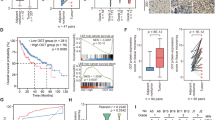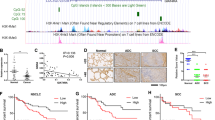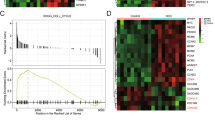Abstract
Cancer metabolism and epigenetic alteration are two critical mechanisms for tumorigenesis and cancer progression; however, the dynamic interplay between them remains poorly understood. As reported in the article entitled “Chromatin remodeling factor LSH drives cancer progression by suppressing the activity of fumarate hydratase,” which was recently published in Cancer Research, our group examined the physiological role of lymphocyte-specific helicase (LSH) in nasopharyngeal carcinoma (NPC) by focusing on cancer progression and the tricarboxylic acid cycle. We found that LSH was overexpressed in NPC, and its expression associated with Epstein-Barr virus infection. We also found that LSH directly suppressed fumarate hydratase (FH), a key component of the tricarboxylic acid cycle, in combination with euchromatic histone-lysine N-methyltransferase 2 (EHMT2), also known as G9a. Depletion of FH promoted epithelial-mesenchymal transition (EMT). Moreover, LSH controlled expression of tricarboxylic acid cycle intermediates that promote cancer progression, including EMT, through activation by inhibitor of nuclear factor kappa-B kinase alpha (IKKα), a chromatin modifier and transcriptional activator. Our study showed that LSH plays a critical role in cancer progression, which has important implications for the development of novel strategies to treat NPC.
Similar content being viewed by others
Background
Cancer metabolism and epigenetic alteration, especially in chromatin remodeling, are two critical mechanisms for tumorigenesis and cancer progression; however, the dynamic interplay between them in tumors remains poorly understood [1–3]. Lymphocyte-specific helicase (LSH), also called helicase, lymphoid-specific (HELLS), is a member of the ATP-dependent helicase in sucrose nonfermenting 2 (SNF2). LSH is not only involved in DNA methylation, but it also promotes PolII stalling or transcriptional pausing [3–5]. We confirmed that LSH interaction with long non-coding RNA (LncRNA) HOX transcript antisense RNA (HOTAIR) regulates the ratio of FoxA1 to FoxA2 and plays a critical role in lung cancer [6]. Epithelial-mesenchymal transition (EMT) is thought to be activated in cancer cells, linked to their dissociation from the primary tumor and their intravasation into blood vessels [7]. However, the effect of EMT in cancer progression, especially in chromatin remodeling, remains poorly understood. But now, based on the He et al. study, “Chromatin remodeling factor LSH drives cancer progression by suppressing the activity of fumarate hydratase,” published in Cancer Research [8], the interplay between epigenetic controls in chromatin remodeling and EMT has been addressed.
Oncoprotein latent membrane protein 1 (LMP1) encoded by Epstein-Barr virus (EBV) infects more than 90% of the global adult population and contributes to several malignancies, including nasopharyngeal carcinoma (NPC) [9–11], which is a common cancer in South China and in Southeast Asia [12, 13]. Epigenetic changes induced by EBV and its products, such as LMP1, are key events in the viral process of carcinogenesis, including transcriptional pausing [10, 14]. Chromatin remodeling factors are crucial factors of epigenetics and play a critical role in the development of several malignancies [15], but their role in the progress of NPC remains unknown. Recent work from our group provides robust evidence that LSH is highly expressed in NPC, where it is controlled by LMP1 [8]. Furthermore, our group found that LSH not only promotes growth, migration, and invasion of NPC cancer cells in vitro but also links with EMT, including cell migration, invasion, and tumor growth and colonization in vivo [8], suggesting that LSH plays a critical role in tumor growth and metastasis. Based on these findings, it is clear that LSH promotes transition from the epithelial stage to the mesenchymal stage.
Altered cellular metabolism, in particular the Warburg effect, is a hallmark of cancer cells, with the tricarboxylic acid (TCA) cycle at the center of oxidative metabolism, serving as a robust source for intermediates that are required for anabolic reactions [16]. The mitochondrial enzyme fumarate hydratase (FH), a key component of the TCA cycle, catalyzes the hydration of fumarate to malate and is essential for cellular energy production and macromolecular biosynthesis. In studying the molecular mechanism and seeking to identify potential targets mediating the TCA cycle, our group found (using polymerase chain reaction array analysis) a repressive regulatory role of LSH in FH expression. We also confirmed that LSH is an important regulator of FH expression and down-regulates FH protein level in NPC derived from xenograft and clinical samples. We found that LSH was associated with the fh promoter; therefore, FH may serve as a direct target of LSH function. However, LSH may repress the fh promoter independent of DNA methylation, even though LSH is linked with DNA methylation, indicating that another mechanism is involved. G9a, also known as euchromatic histone-lysine N-methyltransferase 2, is an important epigenetic regulator, which monomethylates and dimethylates lysine-9 [17]. Our group provided the evidence of an interaction between LSH and G9a; the evidence of recruitment of G9a to the fh promoter in a LSH-dependent manner; and the evidence of subsequent chromatin modification leading to FH promoter repression [8], thus linking epigenetic regulation by LSH with suppression of the emerging tumor suppressor gene FH.
Oncometabolites are metabolites whose abnormal expression causes metabolic and epigenetic dysregulation and transformation to malignancy [18]. Inactivation of genetic mutations alters the level of 2-oxoglutarate-dependent oxygenases and leads to epigenetic deregulation of oncogenes or tumor suppressors [18, 19]. Diverse metabolites serve as cofactors or substrates for enzymes involved in the deposition or exchange of epigenetic marks, initiating a metabolite-driven pathway of gene regulation [20]. α-Ketoglutaric acid (α-KG) has been shown to influence the pluripotency state in embryonic stem cells via alternation of multiple chromatin modifications [21]. In our study, we found that TCA cycle intermediates and the ratio of α-KG/succinate and α-KG/fumarate are regulated by LSH [8]. However, we found no association between the EBV status and the intermediates of TCA cycles in NPC patients.
The functional interactions between EMT-inducing transcription factors and the modulators of chromatin configuration are central to the underlying mechanism of cancer progression [22]. Metabolic competition can drive cancer progression [23], and this competition is due to the disturbed balance of TCA intermediates that can trigger EMT. The reprogramming of gene expression during EMT is initiated and controlled by signaling pathways that respond to extracellular cues and lead to metabolic reprogramming. In our study, we showed that overexpression of LSH is linked to EMT by increasing migration and invasion ability in NPC [8]. This finding also indicated that EMT induction by LMP1 is mediated by LSH. Furthermore, we found that many other key regulators that induce EMT, such as TWIST and Snail, are affected by LMP1. Moreover, TCA intermediates promote cancer progression through the decrease of epithelial markers and the increase of mesenchymal marker expression.
Recently, abnormal levels of TCA intermediates were shown to activate nuclear factor kappa-B (NF-κB) using a non-canonical pathway independent of inhibitor of nuclear factor kappa-B kinase alpha (IKKα) [24]. Depending on the type of malignancy, IKKα can provide both tumor-promoting and tumor-suppressive mechanisms that are, in most instances, cell autonomous. We recently found that IKKα is diversely expressed in keratinizing and non-keratinizing carcinomas even in the same type of cancer [25]. In addition, we showed that IKKα can localize to the nucleus and that nuclear IKKα can directly bind to the promoters of inflammation factors and leucine-rich repeat containing G-protein-coupled receptor 5 (LGR5), a stem cell marker, thereby up-regulating LGR5 expression through activation of signal transducer and activator of transcription 3 (STAT3) signaling pathway during cancer progression [25, 26]. The chromatin regulator and transcriptional activator IKKα may be involved in the regulation of EMT markers, mediating the effect of LSH and TCA intermediates. LSH overexpression, as well as de-regulation of TCA intermediates, leads to IKKα recruitment to the promoters of EMT-related genes. In this way, LSH induces a cascade of epigenetic and metabolic changes that result in further epigenetic regulations via IKKα and EMT.
Based on our findings, we propose a model for LSH-mediated signaling and enhancement of NPC tumorigenesis (Fig. 1). In this model, LSH acts as a driver of cancer progression, involving EMT, invasion, and migration. Specifically, LSH, together with G9a, represses FH. Reduced FH level leads to a reduction of succinate, fumarate, and malate; it also increases the ratio of α-KG to fumarate. TCA intermediates, including α-KG and citrate, decrease E-cadherin and ZO-1 expression and increase vimentin expression. The changes of EMT marker gene expression are controlled by IKKα, which binds directly to these promoters as a chromatin bona fide modifier. The pathway leads to EMT, promoting migration, invasion, and cancer progression. However, several issues still need to be addressed. First, it remains unclear which signaling pathway is involved in the regulation of LMP1 on LSH (LMP1 is a membrane protein and LSH is a chromatin remodeling in the nucleus). Second, it is necessary to address how and why, in tumor tissues from patients, TCA intermediates change in high levels of LSH expression.
Schematic model of lymphocyte-specific helicase (LSH) in cancer progression. LSH promotes cell growth, migration, and invasion, which are characteristics of cancer progression. The effect of LSH is, in part, mediated by fumarate hydratase (FH), through the intact combination of LSH and euchromatic histone-lysine N-methyltransferase 2 (G9a). FH repression, in turn, leads to changes of tricarboxylic acid cycle (TCA) intermediates, including succinate, fumarate, and malate, and an increase in the ratio of α-ketoglutarate (α-KG) to fumarate. TCA intermediates promote migration, invasion, and epithelial-mesenchymal transition (EMT) through the decrease of E-cadherin and tight junction protein ZO-1 and the increase of vimentin. The changes of E-cadherin and ZO-1 are mediated by inhibitor of nuclear factor kappa-B kinase alpha (IKKα), which directly binds to these promoters
Conclusions
Our findings suggest that LSH acts as a driver in NPC by promoting EMT, cell growth, migration, and invasion, which are key characteristics of cancer progression. Our study highlights the importance of LSH-mediated regulation of TCA intermediates in cancer progression. Repression of LSH and its downstream effects may serve as a potential target for novel therapeutic strategies.
Abbreviations
- LMP1:
-
latent membrane protein 1
References
Katada S, Imhof A, Sassone-Corsi P. Connecting threads: epigenetics and metabolism. Cell. 2012;148(1–2):24–8.
Gut P, Verdin E. The nexus of chromatin regulation and intermediary metabolism. Nature. 2013;502(7472):489–98.
Liu S, Tao Y. Interplay between chromatin modifications and paused RNA polymerase II in dynamic transition between stalled and activated genes. Biol Rev. 2013;88(1):40–8.
Tao Y, Xi S, Shan J, Maunakea A, Che A, Briones V, et al. LSH, chromatin remodeling family member, modulates genome-wide cytosine methylation patterns at nonrepeat sequences. Proc Natl Acad Sci USA. 2011;108(14):5626–31.
Tao Y, Liu S, Briones V, Geiman TM, Muegge K. Treatment of breast cancer cells with DNA demethylating agents leads to a release of Pol II stalling at genes with DNA-hypermethylated regions upstream of TSS. Nucleic Acids Res. 2011;39(22):9508–20.
Wang R, Shi Y, Chen L, Jing Y, Mao C, Yan B, et al. The ratio of foxa1 to foxa2 in lung adenocarcinoma is regulated by lncrna hotair and chromatin remodeling factor lsh. Sci Rep. 2015;5:17826.
Thiery JP, Acloque H, Huang RY, Nieto MA. Epithelial-mesenchymal transitions in development and disease. Cell. 2009;139(5):871–90.
He X, Yan B, Liu S, Jia J, Lai W, Xin X, et al. Chromatin remodeling factor lsh drives cancer progression by suppressing the activity of fumarate hydratase. Cancer Res. 2016. (Epub ahead of print).
Young LS, Dawson CW. Epstein-Barr virus and nasopharyngeal carcinoma. Chin J Cancer. 2014;33(12):581–90.
Tao Y, Shi Y, Jia J, Jiang Y, Yang L, Cao Y. Novel roles and therapeutic targets of epstein-barr virus-encoded latent membrane protein 1-induced oncogenesis in nasopharyngeal carcinoma. Expert Rev Mol Med. 2015;17:e15.
Shi Y, Peng SL, Yang LF, Chen X, Tao YG, Cao Y. Co-infection of Epstein-Barr virus and human papillomavirus in human tumorigenesis. Chin J Cancer. 2016;35(1):16.
Wei KR, Zheng RS, Zhang SW, Liang ZH, Ou ZX, Chen WQ. Nasopharyngeal carcinoma incidence and mortality in China in 2010. Chin J Cancer. 2014;33(8):381–7.
Zhang LF, Li YH, Xie SH, Ling W, Chen SH, Liu Q, et al. Incidence trend of nasopharyngeal carcinoma from 1987 to 2011 in Sihui County, Guangdong Province, South China: an age-period-cohort analysis. Chin J Cancer. 2015;34(8):350–7.
Jiang Y, Yan B, Lai W, Shi Y, Xiao D, Jia J, et al. Repression of Hox genes by LMP1 in nasopharyngeal carcinoma and modulation of glycolytic pathway genes by HoxC8. Oncogene. 2015;34(50):6079–91.
Suva ML, Riggi N, Bernstein BE. Epigenetic reprogramming in cancer. Science. 2013;339(6127):1567–70.
Hanahan D, Weinberg RA. Hallmarks of cancer: the next generation. Cell. 2011;144(5):646–74.
Shinkai Y, Tachibana M. H3K9 methyltransferase G9a and the related molecule GLP. Genes Dev. 2011;25(8):781–8.
Thompson CB. Metabolic enzymes as oncogenes or tumor suppressors. N Engl J Med. 2009;360(8):813–5.
Adam J, Yang M, Soga T, Pollard PJ. Rare insights into cancer biology. Oncogene. 2014;33(20):2547–56.
Pavlova NN, Thompson CB. The emerging hallmarks of cancer metabolism. Cell Metab. 2016;23(1):27–47.
Carey BW, Finley LW, Cross JR, Allis CD, Thompson CB. Intracellular alpha-ketoglutarate maintains the pluripotency of embryonic stem cells. Nature. 2015;518(7539):413–6.
Tam WL, Weinberg RA. The epigenetics of epithelial-mesenchymal plasticity in cancer. Nat Med. 2013;19(11):1438–49.
Chang CH, Qiu J, O’Sullivan D, Buck MD, Noguchi T, Curtis JD, et al. Metabolic competition in the tumor microenvironment is a driver of cancer progression. Cell. 2015;162(6):1229–41.
Shanmugasundaram K, Nayak B, Shim EH, Livi CB, Block K, Sudarshan S. The oncometabolite fumarate promotes pseudohypoxia through noncanonical activation of NF-kappaB signaling. J Biol Chem. 2014;289(35):24691–9.
Xiao D, Jia J, Shi Y, Fu C, Chen L, Jiang Y, et al. Opposed expression of IKKalpha: loss in keratinizing carcinomas and gain in non-keratinizing carcinomas. Oncotarget. 2015;6(28):25499–505.
Jia J, Shi Y, Yan B, Xiao D, Lai W, Pan Y, et al. LGR5 expression is controled by IKKα in basal cell carcinoma through activating STAT3 signaling pathway. Oncotarget. 2016. doi:10.18632/oncotarget.8465.
Authors’ contributions
SL drafted the manuscript. YGT reviewed and revised the manuscript. Both authors read and approved the final manuscript.
Acknowledgements
We thank all members of the Tao Lab for critical discussions.
Competing interests
The authors declare that they have no competing interests.
Funding
This study was supported by grants from the National Basic Research Program of China [2015CB553903 (YGT)]; the National Natural Science Foundation of China [81171881 and 81372427 (YGT) and 81271763 (SL)]; and the Hunan Natural Science Foundation of China [12JJ1013 (YGT)].
Author information
Authors and Affiliations
Corresponding author
Additional information
An erratum to this article is available at http://dx.doi.org/10.1186/s40880-016-0156-5.
Rights and permissions
Open Access This article is distributed under the terms of the Creative Commons Attribution 4.0 International License (http://creativecommons.org/licenses/by/4.0/), which permits unrestricted use, distribution, and reproduction in any medium, provided you give appropriate credit to the original author(s) and the source, provide a link to the Creative Commons license, and indicate if changes were made. The Creative Commons Public Domain Dedication waiver (http://creativecommons.org/publicdomain/zero/1.0/) applies to the data made available in this article, unless otherwise stated.
About this article
Cite this article
Liu, S., Tao, YG. Chromatin remodeling factor LSH affects fumarate hydratase as a cancer driver. Chin J Cancer 35, 72 (2016). https://doi.org/10.1186/s40880-016-0138-7
Received:
Accepted:
Published:
DOI: https://doi.org/10.1186/s40880-016-0138-7





